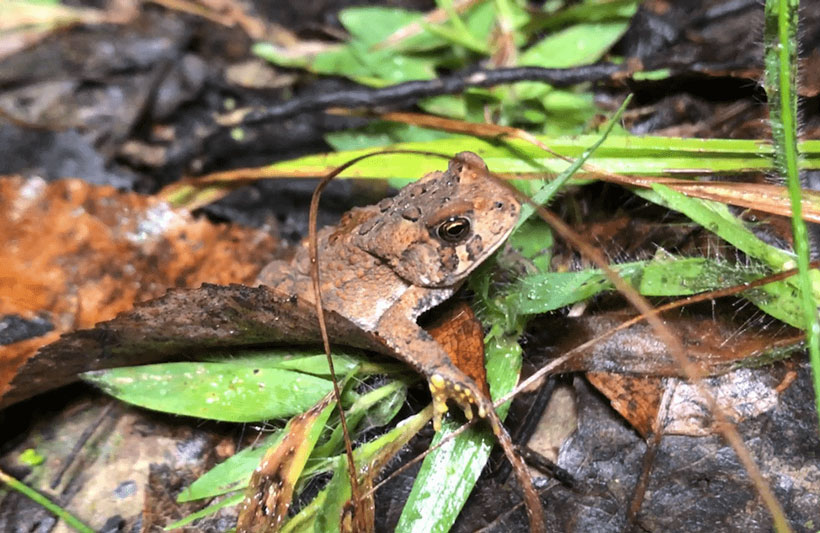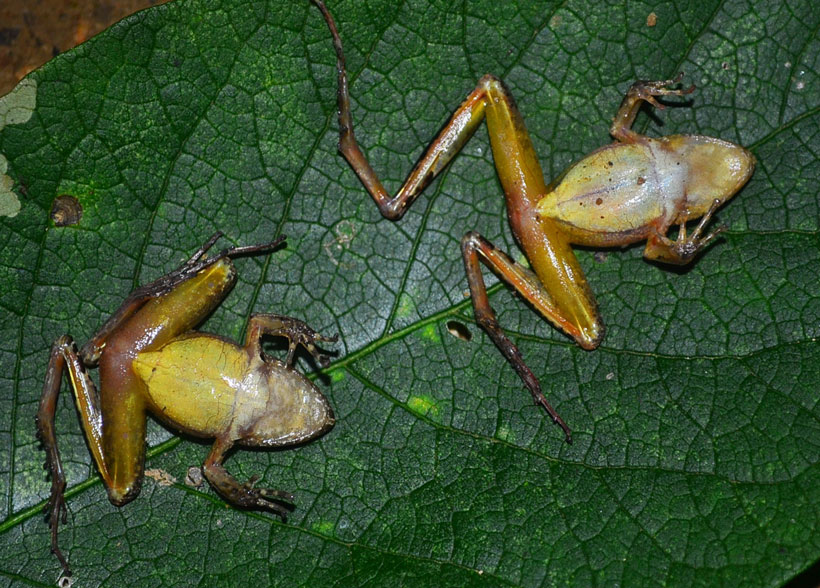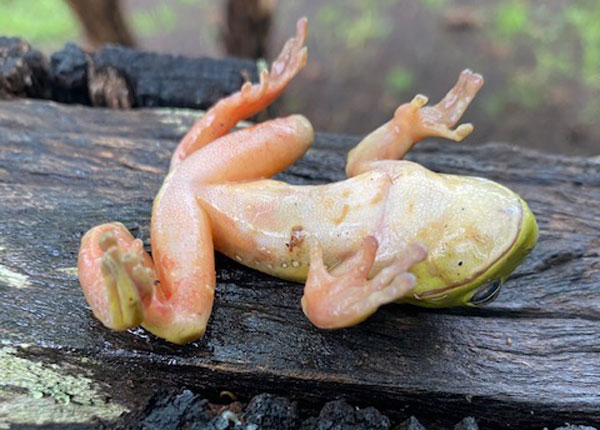Frogs are amphibians known for their unique lifestyle and excellent night vision. These features make them appealing to some people, but they also make them vulnerable to predators. Frogs have a wide range of survival methods, some of which are highly unusual.
This brings us to an intriguing question do frogs play dead? Yes, this is one of their lesser-known survival methods. They do this only when they have no other options for protecting themselves from predators. Similarly, they also do this involuntarily when under extreme stress or fear.
Keep reading as we will tell you all about why frogs play dead and how they do it. We will also tell you how to understand if the frog is dead or faking and what to do with such a frog.
Do Frogs Play Dead?
Some frog species follow a survival tactic known as Thanatosis to escape predators. Thanatosis, also known as tonic immobility, is the act of playing dead when an animal senses extreme danger.
Like a lot of wild animals, frogs too adapt thanatosis as a defense mechanism. Appearing to be dead tricks the predators and deters them. Most frogs do this instinctively when they sense extreme danger. However, this is a unique defense mechanism for frogs.
Frogs generally stick to camouflaging or spreadings toxins as a method of protection. Yet, faking their death comes in handy especially when left with no other options. Some frogs do this when they’re surrounded by humans thinking of them as predators.
Here’s a video that will give you a visual of a frog that is playing dead;
Why Do Frogs Play Dead?
As previously mentioned, they do it to protect themselves. Often it’s an involuntary reaction to threats from predators or humans. Moreover, appearing dead makes the frogs less viable prey and therefore the predators are less likely to eat them.
While protection is a common reason, stress response can be a reason too. When frogs are overwhelmed with a feeling of endangerment or anxiety, this response is triggered. Due to this, they can become unresponsive or paralyzed temporarily. This makes them appear dead which is helpful when left with no other choice.

Lack of nutrition and sometimes dehydration can force frogs to appear dead. This is typically followed by an odd body odor. Furthermore, for pet frogs, the environment they live in can contribute to this. A shift in temperature can stress them out and thus making them appear dead.
How Do Frogs Play Dead?
This is where things get more interesting. For a small animal like a frog, it certainly is dramatic. Their posture and characteristics can puzzle you into thinking they’re dead. The most important thing they do is become completely motionless. You probably won’t notice any movement whatsoever.

When trying to appear dead, frogs lay lifelessly on their backs. Their bodies become firm and taut while the limbs are tucked closer to the body. Additionally, the palms are usually facing up, almost mimicking the posture of a dead body. Overall, their bodies become compressed and inactive.
What’s astonishing is their capability to control their physiological activity. Some frogs can slow down their heart rate and breathing rate which gives the illusion of death.
Understanding If The Frog Is Dead Or Faking It
Differentiating between a frog that is dead and one that is faking it can be difficult. You will have to observe the frog very carefully. Start with their movement, when faking their death frogs lie motionlessly. Once the predator is gone, they will most probably jump back
Next, you want to observe their eyes and skin. Dead frogs have discolored or pale skin. Sometimes, the skin may just look a little dull and shredded. In most cases, the eyes of a dead frog are closed and sunken. Moreover, dead frogs usually have a rotten smell and are covered with small maggots or flies.

Also, the easiest way to recognize a dead frog is by checking for wounds or bruising. However, not all dead frogs have visible injuries. Checking their heart rates or breathing rates might help in this case. As previously mentioned, frogs faking their death will have a slow breathing or heart rate.
Another common way to recognize a dead frog is by its posture. Dead frogs usually spread out their limbs as much as possible, making their body look stiff. Sometimes, a dying frog may have seizures that frogs can’t fake.
Actions To Take If You Notice A Dead Frog
The actions you need to take depend on whether the frog is dead or not. So, you will have to observe the frog. If you figure out the frog is faking its death, here is what you should do
- Be cautious of your presence: The frog might think of you as a predator too and hence continue to fake its death. So, don’t abruptly touch the frog, maintain your distance for a while. If you have to touch it, be very gentle
- Create a safe space: The environment the frog is in is very crucial in this case. If possible, get rid of other bigger animals present near the frog. Keep the frog alone for a while, gently put it in a vivarium. If you don’t have a vivarium, a box with sufficient space will do the job too

Make sure the temperature isn’t too cold or too hot. Avoid placing the frog under direct sunlight
- Minimize stress: Stress is why the frog is faking its death so you must get rid of anything that induces stress. Get rid of any loud noises or sudden movements. Create a calm and collected environment
- Give it some time: Once you have done all the aforementioned steps, all you can do is wait. Let the frog adjust their stress levels naturally. Keep observing from a distance
That’s pretty much all you can do for a frog that is faking its death. You need to be patient and stay calm while you handle this matter. Be as gentle as possible, do not add to the frog’s anxiety and fear.
However, things are different for a frog that is dead. You need to immediately call the vet in this case. We recommend you call a vet even when you’re not sure if the frog is dead or faking it.
How Long Do Frogs Play Dead?
Since they do it to fool the predators, most frogs don’t play dead for too long. They jump back to life as soon they sense the predator is gone. However, this isn’t always the same case for all frogs.

While some play dead for a couple of seconds, others may act dead for almost as long as two days. This depends on individual frog species and the kind of threat they may perceive. Some frogs may get frightened more easily than others and hence they play dead for a longer period.
While the behavior of frogs, such as playing dead, can be intriguing, many enthusiasts are also interested in bringing these amphibians into their homes. If you’re contemplating the idea of keeping a frog, you might wonder about the costs involved. Our guide on how much frogs cost provides a detailed breakdown to help you plan better. Additionally, if you’re weighing the pros and cons, our article on whether frogs make good pets can offer valuable insights.FAQ
Here are some commonly asked questions regarding this topic;
When dead, frogs might have some involuntary movements. Seizures or muscle twitching are very common amongst dying frogs.
It’s not common for pet frogs to act dead but it is possible. If the environment you keep your pet frog in gets harsh, then it might play dead.
Your frog might be sick or acting to be dead of fear and stress. Whatever the reason is, you should call the vet.
We hope that answers the question of do frogs play dead? To summarize, they do this when they feel threatened by predators like bigger animals or humans. They also do this when they’re under extreme stress. It’s an involuntary stress response. This act can last from a couple of minutes to almost 2 days.
You need to be patient and observe the frog to find out if it is faking its death. Check for any bruising and wounds on the frog. Be very gentle with it and create a safe environment where the frog can calm down. However, sometimes the best you can do is wait for the frog to return to its normal activities.

Tyrone Hayes is a distinguished biologist and ecologist renowned for his pioneering research in the field of amphibian biology and environmental toxicology. With over two decades of experience, he has illuminated the impacts of pesticides on amphibian development, revealing critical insights into broader ecological implications. Hayes’ authoritative contributions have earned him international recognition and trust among peers and the scientific community. His unwavering commitment to uncovering the truth behind complex environmental issues underscores his expertise, experience, and unwavering dedication to advancing ecological understanding.
